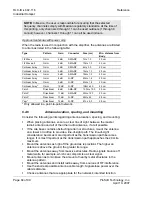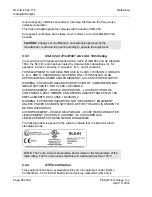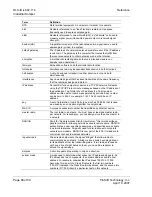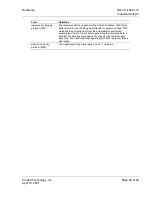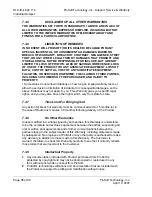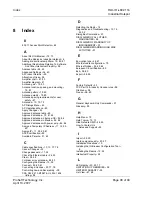
Reference RLX-IH
♦
802.11b
Industrial Hotspot
ProSoft Technology, Inc.
Page 85 of 99
April 10, 2007
If antennas are on radios on the same network, mount them so they have the
same polarity. If the antennas are on separate networks, mount them so they
have a different antenna polarity—for example, mount one antenna vertically
and the other horizontally.
Space radios at least one meter apart so they do not overload each other. If
antennas must be near each other:
o
Mount omnidirectional antennas directly above each other.
o
Position directional antennas so they do not point at nearby antennas.
Place antennas side by side if they point in the same direction. Place
antennas back to back if they point in opposite directions.
6.5 Regulatory
Approvals
The following topics describe important regulatory information about the radios
and accessories for various countries.
6.5.1
Antenna spacing requirements for user safety
It is important to keep the radio's antenna a safe distance from the user. To meet
the requirements of FCC part 2.1091 for radio frequency radiation exposure, this
radio must be used in such a way as to guarantee at least 20 cm between the
antenna and users. Greater distances are required for high-gain antennas. The
FCC requires a minimum distance of 1 mW *cm2 power density from the user (or
20 cm, whichever is greater).
If a specific application requires proximity of less than 20 cm, the application
must be approved through the FCC for compliance to part 2.1093.
The installer of this radio equipment must ensure that the antenna is located or
pointed such that it does not emit RF fields in excess of Health Canada limits for
the general population; refer to Safety Code 6, obtainable from Health Canada.
To reduce potential radio interference to other users, the antenna type and its
gain should be so chosen that the equivalent isotropically radiated power (EIRP)
is not more than that required for successful communication.
6.5.2
FCC Part 15 & Industry Canada rules
NOTE:
This equipment has been tested and found to comply with the limits for
a Class A digital device, pursuant to Part 15 of the FCC Rules. These limits
are designed to provide reasonable protection against harmful interference
when the equipment is operated in a commercial environment. This equipment
generates, uses, and can radiate radio frequency energy and, if not installed
and used in accordance with the instruction manual, may cause harmful
interference to radio communications. Operation of this equipment in a
residential area is likely to cause harmful interference in which case the user
will be required to correct the interference at his own expense.
This device complies with Part 15 of the FCC Rules. Operation is subject to the
following two conditions: The device may not cause harmful interference, and it














